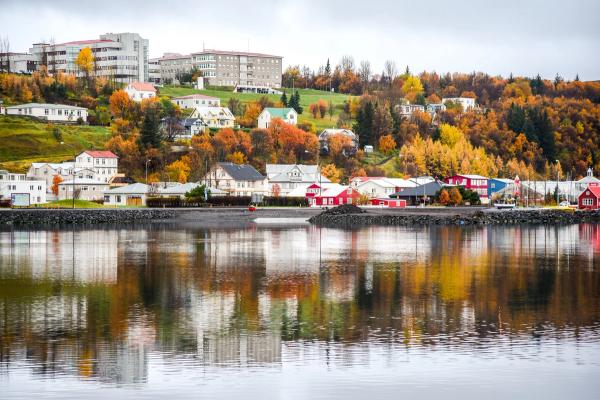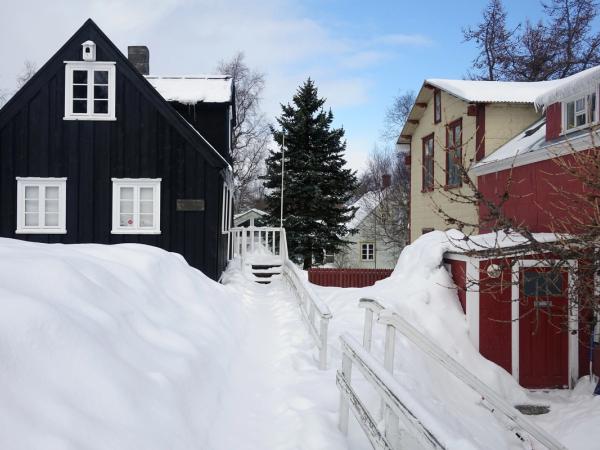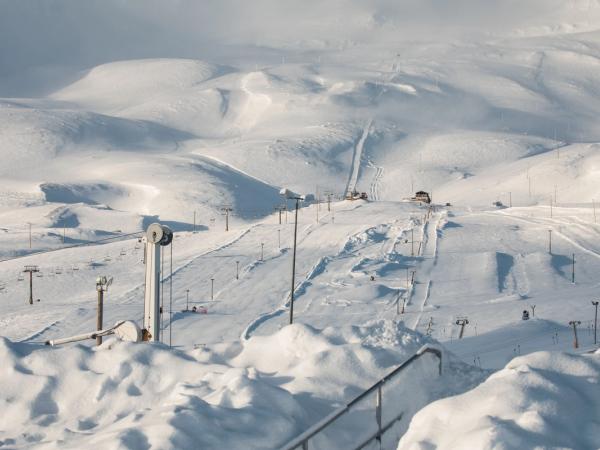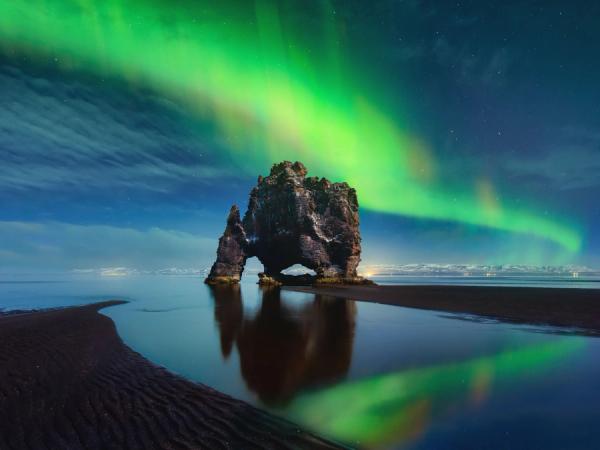
Akureyri Iceland Weather: What to Expect
Akureyri is the second-largest city in Iceland, known as the "capital of the north." It sits at the foot of the longest fjord in the country, Eyjafjordur. This city gives visitors a peek into the changing weather and seasons of northern Iceland. It's a key spot for travelers, making it vital to know the local climate to enjoy your visit.
This guide will cover Akureyri's weather, from the mild Gulf Stream-influenced temperatures to the unpredictable weather patterns of Iceland. It will also highlight the best times to visit. Whether you want the sunny summers or the stunning Northern Lights in winter, this guide has you covered.
This guide will cover Akureyri's weather, from the mild Gulf Stream-influenced temperatures to the unpredictable weather patterns of Iceland. It will also highlight the best times to visit. Whether you want the sunny summers or the stunning Northern Lights in winter, this guide has you covered.
Key Takeaways
- Akureyri, the "capital of the north," offers a unique weather experience in Iceland.
- The city's climate is influenced by the Gulf Stream, resulting in milder temperatures compared to other parts of the country.
- Visitors can expect a range of weather conditions, from unpredictable precipitation to rapid changes in temperature and wind speed.
- Understanding the seasonal variations in Akureyri's weather is crucial for planning the best time to visit.
- Akureyri's weather patterns are diverse, with both the warm, sunny summers and the mesmerizing Northern Lights during the winter months.
Understanding Iceland's Climate
Iceland's climate is surprisingly mild, given its location just south of the Arctic Circle. This is thanks to the Gulf Stream, a warm ocean current from the Caribbean. It flows along Iceland's west and south coasts, warming the country. Iceland sits on a hot spot on Earth, filled with geothermal activity. This includes hot springs, geysers, and volcanoes, which also help keep temperatures moderate.
Iceland's Mild Temperatures
In Reykjavik, the capital, winters are around 33-35°F (1-2°C) and summers about 54°F (12°C). Akureyri, further north, has cooler summers and colder winters. The Westfjords, where Isafjordur is, have a milder climate than expected. But, heavy snow in winter can make it hard to access.
The Gulf Stream's Influence
The Gulf Stream is key to Iceland's mild climate. It brings warmth from the Caribbean. This warm current affects the west and south coasts, shaping the weather and temperatures there.
Geothermal Activity and Tectonic Plates
Iceland sits where the Eurasian and North American tectonic plates meet. This spot makes it a hotspot for geothermal activity. Hot springs, geysers, and volcanoes are common. They help keep temperatures moderate, even in winter. Despite its mild climate, Iceland's weather is unpredictable. Warm Atlantic air and cold Arctic air mix often, leading to sudden changes. This means the weather can change a lot over the year and even within a day. So, visitors should always be ready for different weather.
Weather in Akureyri, Iceland
Akureyri is a lively city in northern Iceland. It has its own weather patterns, different from the south. Being the second-largest city, it shows the diverse climate of Iceland.
Summer Weather in Akureyri
In summer, Akureyri gets warmer than Reykjavik, the capital. The average high is about 52°F (11°C) here, compared to Reykjavik's 54°F (12°C). This is because Akureyri is farther north, leading to warmer summers.
Winter Weather in Akureyri
Winters in Akureyri are colder than in Reykjavik. The average temperature is around 32°F (0°C), while Reykjavik is a bit warmer. Akureyri gets more snow and has longer, darker winters due to its location.
The weather in Akureyri, like all of Iceland, is hard to predict. Weather can change fast, with rain, snow, and even hail throughout the year. This keeps everyone, locals, and visitors, always ready for something new.
Knowing the weather in Akureyri is key to planning your visit. Whether you're here in summer or winter, understanding the Akureyri weather patterns will enhance your experience. This way, you can enjoy everything this beautiful city has to offer.
Seasons in Akureyri
Akureyri, in northern Iceland, has four clear seasons. Each season brings its own weather and charm. The town's location makes its climate more extreme than the south.
Spring Weather in Akureyri
Spring in Akureyri is cool and wet, with temperatures from just above freezing to 50°F (10°C). Snow is still common, and melting snow can cause flooding. But, the warming weather and colorful plants signal spring's start.
Autumn Weather in Akureyri
Autumn in Akureyri gets stormier, with strong winds and more rain and snow. Yet, it's beautiful, with the town's trees turning colors. Migratory birds, like puffins, also make their way back, adding to the beauty of akureyri autumn weather. The weather in Akureyri changes fast, with sudden shifts in wind and rain. But, the people and visitors love the unique challenges and joys of living here. They find beauty in both the akureyri spring weather and akureyri autumn weather, just as much as in summer and winter.

Akureyri Iceland Weather
Akureyri, in northern Iceland, has a unique climate. It's colder and snowier than southern parts of the country. This city is the second-largest in Iceland. It gets more snow and has longer, darker winters than places like Reykjavik. But, the Gulf Stream and geothermal activity keep the cold at bay. This makes the weather unpredictable. You can see big changes in weather, like rain, wind, and temperature, in just one day.
| Weather Statistic | Range |
| Temperature | 52°F (11.1°C) at night to 63°F (17.2°C) during the day |
| Precipitation Chance | 7% at night to 75% during the day |
| Wind Speed | 5 to 17 mph (8 to 27.4 kph) |
| Humidity | Consistently around 71% |
| UV Index | Low, ranging from 1 to 4 |
| Barometric Pressure | 29.6 inches (1001.0 millibars) |
| Visibility | 10.00 miles (16.10 km) |
Knowing about the akureyri iceland weather is key for visitors. It helps with planning and packing for the trip. Whether you want to see the Northern Lights or explore nature, being ready for the weather is important.
"The weather in Akureyri is as dynamic as the landscape itself, with a constant interplay of temperature, precipitation, and wind that can change in the blink of an eye. It's a true adventure for the senses."
Visiting Akureyri: The Best Time
Choosing the best time to visit Akureyri, Iceland, depends on what you want to experience. This city, with fewer than 20,000 people, has attractions for every season. It's perfect for different kinds of travelers.
Summer: The High Season
Summer is the peak season to visit Akureyri. The weather is warm and dry, with long days. It's great for outdoor fun and seeing the sights. The city's beautiful garden, hiking paths, and Arctic Circle location make summer visits special.
Winter: Northern Lights and Ice Caves
Winter in Akureyri is cold and snowy, with long nights. But, it's a great time to see the Northern Lights and ice caves. The winter weather is tough, but the scenery is magical. It turns into a winter wonderland, perfect for Akureyri tourism. There's no bad time to visit Akureyri. Each season has its own charm and adventures. The best time depends on what you like and the adventure you're looking for.
Unpredictable Weather Patterns
Akureyri and Iceland are known for their unpredictable weather. The area sits between the Gulf Stream's warmth and the Arctic's cold. This mix leads to a climate that changes quickly, often in just minutes. You might see all four seasons in one day, with the weather going from sunny to rainy or snowy fast.
Rapid Weather Changes
The weather in Akureyri changes quickly, especially with the wind and rain. Where you are matters a lot. If you're by the coast, in a valley, or on a glacier, the weather can be different. It's important to be ready for these changes when you visit Akureyri and see the beautiful but tough landscapes of northern Iceland.
Wind and Precipitation Variations
Akureyri's weather is affected by its location near the coast, mountains, and glaciers. This leads to big changes in wind and rain. In July 2023, the average temperature was 9.6°C, which was 1.6°C below the usual average. This shows how unpredictable the weather can be, with big temperature changes in a short time.





